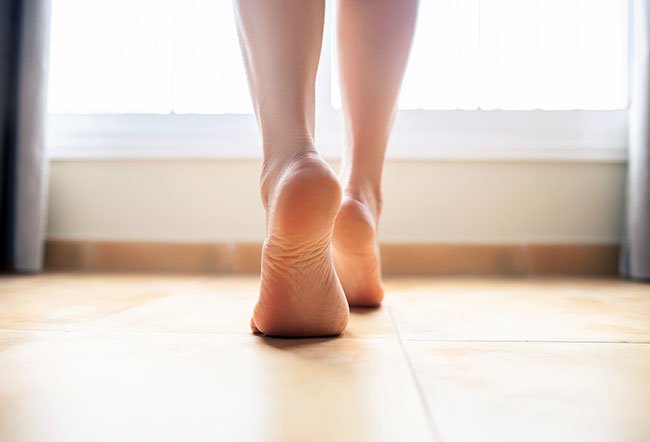What Causes Dry Cracked Feet?

Cracked heel is a common ailment affecting people of all genders. It is often a source of embarrassment and even pain. Some of the risk factors include:
- Dry skin
- Prolonged standing, especially on hard floors
- Biomechanical issues that increase pressure in the heel area such as a poor posture
- Obesity, which increases the pressure on the normal fat pad under the heel, causing it to expand sideways
- Open backs on shoes or sandals, which allow the fat pads in the heel to expand sideways and increase pressure on the skin
- Walking around barefooted
- Genetics
- Ill-fitting shoes or sandals that don’t support the heels
- Deficiency of vitamins, minerals, or zinc
- Hormonal conditions such as thyroid or estrogen imbalances
- Circulation problems
Medical conditions that may cause cracked heels to include:
- Diabetic neuropathy (people lose the ability to perspire)
- Sjogren’s syndrome (an autoimmune disorder that causes skin dryness)
- Psoriasis
- Eczema
- Fungal infections
- Hypothyroidism
- Juvenile plantar dermatosis (a common and chronic dry skin condition of the feet)
- Palmoplantar keratoderma (a group of skin conditions characterized by thickening of the skin on the palms of the hands and soles of the feet)
- Pregnancy
- Kidney disease or diuretics
- Lymphoma
- Venous stasis dermatitis (skin inflammation in the lower legs caused by fluid buildup)
- Down syndrome
Cracked heels are splitting or cracking of the heels due to dryness or thickening of the skin (callus). Callus around the circumference of the heel is the beginning process of cracking. Increased pressure on the fat cushion beneath the heel causes it to expand sideways, leading to cracking of the callus.
What home remedies are useful to treat cracked heels?
Several home remedies may be useful to smooth the cracked heels. Simple home remedies that may be effective to treat cracked heels include:
- Heel balms: Use a heel balm or thick moisturizer twice daily to increase the elasticity of the skin on the heels. The main ingredients of heel balm that help to retain moisture in the skin include:
- Urea
- Alpha hydroxy acid
- Humectant
- Foot soaks: Soaking the foot in warm, plain, or soapy water for about 20 minutes. Next, exfoliate with a foot scrubber and apply Vaseline or Aquaphor immediately after drying. Slipping on a pair of socks over your moisturized feet may lock in moisture.
- Bandages: Wearing bandages or special tissue glue can protect and hold the edges of the cracks.
- Supporting shoes: Take care to wear proper fitting closed shoes to relieve pressure on the feet.
- Lose weight: Losing weight and trying to stay healthy would help to relieve pressure on the feet.
- Exfoliate: Rubbing a pumice stone may help to reduce the thickness of calluses. People with diabetes shouldn't attempt to scrub their feet with a pumice stone.
- Bathing: Long and hot showers should be avoided instead; opt for short showers with lukewarm water, as it helps to preserve skin’s essential oils.
- Prevent infection: Always keep the crack clean to prevent the risk of infection.
- Diet: The inclusion of essential fatty acids in the diet may help to moisturize the feet.
- Hydration: Stay hydrated by drinking plenty of water.
- Protection: For cracks that seem to be worse, wear a silicone heel cup inside the shoes to get extra protection and moisture lock.
- Consultation: Finally, always consult a podiatrist for better solutions and treatment if the cracked heels seem to be bothersome.
